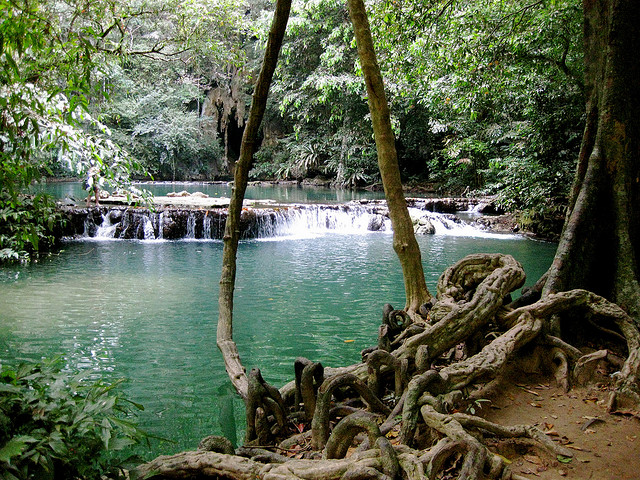
Tharnboke Koranee National Park in Thailand. Photo © Isidro López-Arcos, licensed Creative Commons Attribution.
Thailand has more than its share of national parks, many of which cover not only mainland nature areas but also swaths of sea and some of the islands off the coast.Many parks provide camping and bungalow facilities. The campsites often offer tent rentals, bathrooms with cold-water showers, and even small canteen restaurants serving up more-than-decent local Thai food at reasonable prices.
If your priorities are exploring the natural wonders of Thailand, or you just want to enjoy a beautiful beach or island without too much development around you, staying in one of the parks is an excellent option. It’s also very budget friendly.The national parks also rent out simple bungalows with bathrooms with cold-water showers, and some of them even have air-conditioning. Beds are provided, but generally not linens, so you’ll have to bring your own sheets.
If your priorities are exploring the natural wonders of Thailand, or you just want to enjoy a beautiful beach or island without too much development around you, staying in one of the parks is an excellent option. It’s also very budget friendly. Pitching a tent will cost around 100 baht per night, and renting one of the bungalows often costs less than 1,000 baht per night.
During low season, it’s possible to walk out to one of the park stations and ask if there are available bungalows, but even then there are times when the bungalows are booked solid for weeks. If you’re interested in staying at one of the national parks, make sure to book a bungalow as far in advance as possible. You can book up to 60 days in advance, and in order to reserve a spot, the national parks department requires that you pay, in full, before you arrive. To do that from abroad, you’ll have to make a wire transfer to the National Park, Wildlife and Plant Conservation Department. Although the process can seem a little daunting, they’ve laid out the bank codes you’ll need to use at their website’s Reservation How-to. Once you’ve confirmed that there is an available bungalow and transferred the funds, you must email [email protected] and [email protected] with the confirmation information.
All national parks are open 8:30 a.m.–6 p.m. daily. Nearly all of the parks used to charge an entry fee of 200 baht for foreigners; many have raised the fee to 400 baht.
You may find that the mainland parks lack many well-marked hiking trails, and when they are marked, they are often only a couple of kilometers long. Since there are so few trails, it’s also seemingly impossible to get around the parks without wheels of your own. It is not advisable to arrive at a national park without transportation. There is generally no public transportation within a park, sights are miles apart, and it’s difficult to even get a trail map once you arrive. Many parks have large main roads cutting through them, making driving a convenient, though not very environmentally friendly, way to cover a lot of ground. But once away from the roads, you’ll find the parks peppered with amazing waterfalls, beautiful scenery, and wildlife.
Thais who visit national parks (and this is the vast majority of visitors) are usually not hikers. Most visitors drive from parking lot to parking lot to see waterfalls and viewpoints, and that’s really how the parks are designed to be used. Information centers rarely have trail maps available, and when they do, they usually are not in English.
Excerpted from the Fifth Edition of Moon Bangkok.